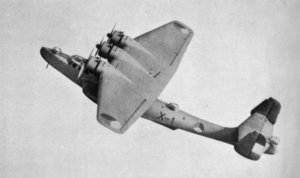Dornier Do 24
|
|
| Dornier Do 24 | ||
|---|---|---|

| ||
| Description | ||
| Role | Bomber & reconnaissance | |
| Crew | 3+ | |
| First flight | July 3, 1937 | |
| Entered service | November, 1937 | |
| Manufacturer | Dornier, Aviolanda, Potez, CASA | |
| Dimensions | ||
| Length | 22 m | 72 ft 2 in |
| Wingspan | 27 m | 88 ft 6 in |
| Height | 5.9 m | 19 ft 3 in |
| Wing area | 108 m² | 1,162 ft² |
| Weights | ||
| Empty | 13,470 kg | 29,700 lb |
| Loaded | 18,400 kg | 40,565 lb |
| Maximum takeoff | kg | lb |
| Powerplant | ||
| Engine | 3 × Bramo 323 | |
| Power (each) | 750 kW | 1,000 hp |
| Performance | ||
| Maximum speed | 341 km/h | 212 mph |
| Combat range | 4,700 km | 2,920 miles |
| Ferry range | km | miles |
| Service ceiling | 5,900 m | 19,357 ft |
| Rate of climb | m/min | ft/min |
| Armament | ||
| Guns | 1 × MG 151 20 mm cannon 2 × MG 15 7.92 mm m/c guns | |
| Bombs | 12 × 50 kg bombs | |
The Dornier Do 24 flying-boat was originally designed for Netherlands service, and part of the original Netherlands order was built under licence by Aviolanda and powered by Curtiss-Wright Cyclone engines. After the German invasion, production for the Luftwaffe continued at Aviolanda, and the type was also produced by Potez in occupied France.
After the war, captured Dornier Do 24s continued in French Naval service until 1955. Some of these were sold to Spain joining a batch purchased in 1944, and continued in use until 1967 for Search and Rescue (SAR) operations, the last large flying-boats in regular use in Europe.
A total of nearly 250 Do 24s were built.
Template:Mil-stub Template:Aero-stub
| Related content | |
|---|---|
| Related development | |
| Similar aircraft | |
| Designation series | |
| Related lists | |
|
Lists of Aircraft | Aircraft manufacturers | Aircraft engines | Aircraft engine manufacturers Airports | Airlines | Air forces | Aircraft weapons | Missiles | Timeline of aviation |
